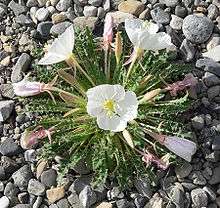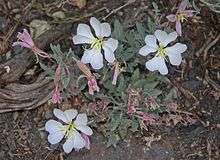Oenothera caespitosa
Oenothera caespitosa, known commonly as tufted evening primrose, desert evening primrose, rock-rose evening primrose, or fragrant evening primrose, is a perennial plant of the genus Oenothera native to much of western and central North America. It produces a rosette of lobed or toothed leaves each up to 36 centimeters long around a woody caudex. It is normally night-blooming.[1]
| Oenothera caespitosa | |
|---|---|
 | |
| Oenothera caespitosa var. marginata | |
| Scientific classification | |
| Kingdom: | Plantae |
| Clade: | Tracheophytes |
| Clade: | Angiosperms |
| Clade: | Eudicots |
| Clade: | Rosids |
| Order: | Myrtales |
| Family: | Onagraceae |
| Genus: | Oenothera |
| Species: | O. caespitosa |
| Binomial name | |
| Oenothera caespitosa | |

There are many subtaxa, referred to as subspecies or varieties.
Oenothera caespitosa grows to 10 centimeters (4 inches) tall. It is good for rock gardens. The 4-petaled white flowers open at dusk and wilt the next morning, turning pink.[2]
It is a larval host to the white-lined sphinx moth.[3]
Pollination
Oenothera caespitosa is dependent on hawkmoths, including the five-spotted hawkmoth (Manduca quinquemaculata) for pollination.[4]
References
- The Xerces Society (2016), Gardening for Butterflies: How You Can Attract and Protect Beautiful, Beneficial Insects, Timber Press.
- "Botanica. The Illustrated AZ of over 10000 garden plants and how to cultivate them", p. 612. Könemann, 2004. ISBN 3-8331-1253-0
- The Xerces Society (2016), Gardening for Butterflies: How You Can Attract and Protect Beautiful, Beneficial Insects, Timber Press.
- Hodges, Scott A. "Some preliminary Observations on Hawkmoth Pollination of Oenothera caespitosa and Mirabilis multiflora" (PDF): 244–249. Cite journal requires
|journal=(help)